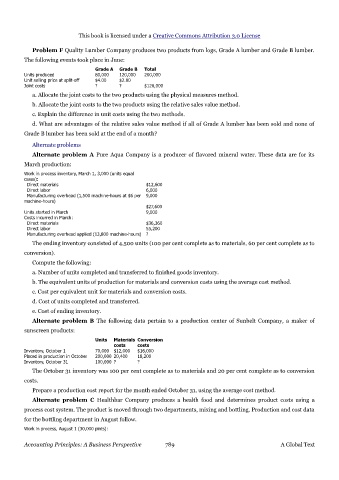Page 788 - Accounting Principles (A Business Perspective)
P. 788
This book is licensed under a Creative Commons Attribution 3.0 License
Problem F Quality Lumber Company produces two products from logs, Grade A lumber and Grade B lumber.
The following events took place in June:
Grade A Grade B Total
Units produced 80,000 120,000 200,000
Unit selling price at split-off $4.00 $2.00
Joint costs ? ? $120,000
a. Allocate the joint costs to the two products using the physical measures method.
b. Allocate the joint costs to the two products using the relative sales value method.
c. Explain the difference in unit costs using the two methods.
d. What are advantages of the relative sales value method if all of Grade A lumber has been sold and none of
Grade B lumber has been sold at the end of a month?
Alternate problems
Alternate problem A Pure Aqua Company is a producer of flavored mineral water. These data are for its
March production:
Work in process inventory, March 1, 3,000 (units equal
cases):
Direct materials $12,600
Direct labor 6,000
Manufacturing overhead (1,500 machine-hours at $6 per 9,000
machine-hours)
$27,600
Units started in March 9,000
Costs incurred in March:
Direct materials $36,360
Direct labor 55,200
Manufacturing overhead applied (13,800 machine-hours) ?
The ending inventory consisted of 4,500 units (100 per cent complete as to materials, 60 per cent complete as to
conversion).
Compute the following:
a. Number of units completed and transferred to finished goods inventory.
b. The equivalent units of production for materials and conversion costs using the average cost method.
c. Cost per equivalent unit for materials and conversion costs.
d. Cost of units completed and transferred.
e. Cost of ending inventory.
Alternate problem B The following data pertain to a production center of Sunbelt Company, a maker of
sunscreen products:
Units Materials Conversion
costs costs
Inventory, October 1 70,000 $12,000 $16,000
Placed in production in October 200,000 20,400 18,200
Inventory, October 31 100,000 ? ?
The October 31 inventory was 100 per cent complete as to materials and 20 per cent complete as to conversion
costs.
Prepare a production cost report for the month ended October 31, using the average cost method.
Alternate problem C Healthbar Company produces a health food and determines product costs using a
process cost system. The product is moved through two departments, mixing and bottling. Production and cost data
for the bottling department in August follow.
Work in process, August 1 (30,000 pints):
Accounting Principles: A Business Perspective 789 A Global Text

